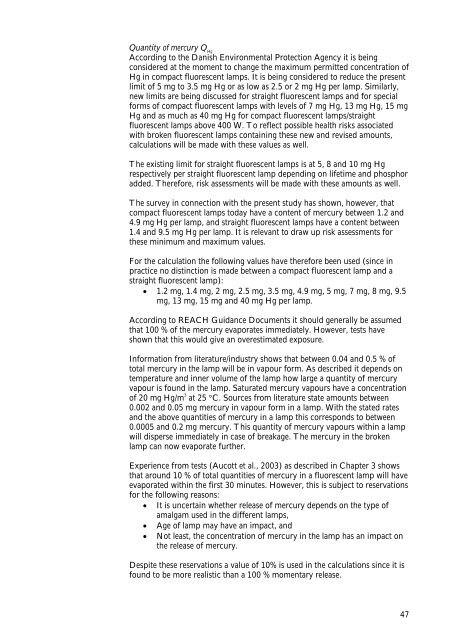No. 104 - Miljøstyrelsen
No. 104 - Miljøstyrelsen
No. 104 - Miljøstyrelsen
Create successful ePaper yourself
Turn your PDF publications into a flip-book with our unique Google optimized e-Paper software.
Quantity of mercury Q Hg<br />
According to the Danish Environmental Protection Agency it is being<br />
considered at the moment to change the maximum permitted concentration of<br />
Hg in compact fluorescent lamps. It is being considered to reduce the present<br />
limit of 5 mg to 3.5 mg Hg or as low as 2.5 or 2 mg Hg per lamp. Similarly,<br />
new limits are being discussed for straight fluorescent lamps and for special<br />
forms of compact fluorescent lamps with levels of 7 mg Hg, 13 mg Hg, 15 mg<br />
Hg and as much as 40 mg Hg for compact fluorescent lamps/straight<br />
fluorescent lamps above 400 W. To reflect possible health risks associated<br />
with broken fluorescent lamps containing these new and revised amounts,<br />
calculations will be made with these values as well.<br />
The existing limit for straight fluorescent lamps is at 5, 8 and 10 mg Hg<br />
respectively per straight fluorescent lamp depending on lifetime and phosphor<br />
added. Therefore, risk assessments will be made with these amounts as well.<br />
The survey in connection with the present study has shown, however, that<br />
compact fluorescent lamps today have a content of mercury between 1.2 and<br />
4.9 mg Hg per lamp, and straight fluorescent lamps have a content between<br />
1.4 and 9.5 mg Hg per lamp. It is relevant to draw up risk assessments for<br />
these minimum and maximum values.<br />
For the calculation the following values have therefore been used (since in<br />
practice no distinction is made between a compact fluorescent lamp and a<br />
straight fluorescent lamp):<br />
� 1.2 mg, 1.4 mg, 2 mg, 2.5 mg, 3.5 mg, 4.9 mg, 5 mg, 7 mg, 8 mg, 9.5<br />
mg, 13 mg, 15 mg and 40 mg Hg per lamp.<br />
According to REACH Guidance Documents it should generally be assumed<br />
that 100 % of the mercury evaporates immediately. However, tests have<br />
shown that this would give an overestimated exposure.<br />
Information from literature/industry shows that between 0.04 and 0.5 % of<br />
total mercury in the lamp will be in vapour form. As described it depends on<br />
temperature and inner volume of the lamp how large a quantity of mercury<br />
vapour is found in the lamp. Saturated mercury vapours have a concentration<br />
of 20 mg Hg/m 3 at 25 °C. Sources from literature state amounts between<br />
0.002 and 0.05 mg mercury in vapour form in a lamp. With the stated rates<br />
and the above quantities of mercury in a lamp this corresponds to between<br />
0.0005 and 0.2 mg mercury. This quantity of mercury vapours within a lamp<br />
will disperse immediately in case of breakage. The mercury in the broken<br />
lamp can now evaporate further.<br />
Experience from tests (Aucott et al., 2003) as described in Chapter 3 shows<br />
that around 10 % of total quantities of mercury in a fluorescent lamp will have<br />
evaporated within the first 30 minutes. However, this is subject to reservations<br />
for the following reasons:<br />
� It is uncertain whether release of mercury depends on the type of<br />
amalgam used in the different lamps,<br />
� Age of lamp may have an impact, and<br />
� <strong>No</strong>t least, the concentration of mercury in the lamp has an impact on<br />
the release of mercury.<br />
Despite these reservations a value of 10% is used in the calculations since it is<br />
found to be more realistic than a 100 % momentary release.<br />
47

















